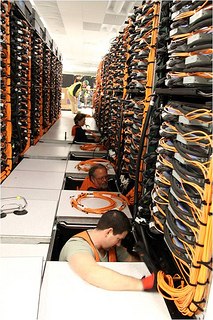 For the first time since November 2009, the United States has a top-ranking supercomputer. IBM’s Sequoia supercomputer at Lawrence Livermore National Laboratory bumped Japan’s K Computer out of the top spot and into second place on the TOP500 List.
For the first time since November 2009, the United States has a top-ranking supercomputer. IBM’s Sequoia supercomputer at Lawrence Livermore National Laboratory bumped Japan’s K Computer out of the top spot and into second place on the TOP500 List.
In all, the United States scored 278 spots in the TOP500, including spots No. 1 and 500. Three US supercomputers made it into the top 10: the Sequoia, an IBM BlueGene/Q system at Argonne National Laboratory in Illinois, and the upgraded Jaguar at Oak Ridge National Laboratory in Tennessee. In the November 2011 TOP500, the Jaguar was the top U.S. supercomputer and the U.S. had 263 computers on the list, whereas China had 74. The latest list includes 68 China-based supercomputers.
Five of the top 10 supercomputers on the latest list are IBM systems, and four of those are IBM BlueGene/Q systems. In all, IBM built 213 (42.6 percent) of the supercomputers on the list. HP built 139 of the TOP500 systems.
As in years past, Linux has performed so well in this space because it’s able to quickly evolve with the latest system design. Academia embraces Linux because it is easier to prototype and there are no restrictions on publishing the source code in a paper, so for the system designers, it makes sense to work in the same environment as the researchers, said Linux Foundation VP Amanda McPherson in her blog post about the TOP500 List results in 2011.
No. 1 Sequoia: Fast and Efficient
The U.S. Department of Energy’s National Nuclear Security Administration (NNSA) announced plans for the IBM Sequoia supercomputer back in 2009 and then unveiled the BlueGene/Q supercomputing system at SC11 last November.
The Sequoia is fast. But the supercomputer, which runs Red Hat Enterprise Linux, is also energy efficient. The National Nuclear Security Administration (NNSA) explains:
“Sequoia is primarily water cooled and consists of 96 racks; 98,304 compute nodes; 1.6 million cores; and 1.6 petabytes of memory. Though orders of magnitude more powerful than such predecessor systems as ASC Purple and Blue Gene/L, Sequoia will be roughly 90 times more power efficient than Purple and about eight times more than BG/L relative to the peak speeds of these systems.”
The NNSA says that the Sequoia is dedicated to its Advanced Simulation and Computing (ASC) program for stewardship of the nation’s nuclear weapons stockpile.
“Sequoia will provide a more complete understanding of weapons performance, notably hydrodynamics and properties of materials at extreme pressures and temperatures,” said Bob Meisner, NNSA director of the ASC program. “In particular, the system will enable suites of highly resolved uncertainty quantification calculations to support the effort to extend the life of aging weapons systems; what we call a life extension program (LEP),” he adds.
According to the NNSA, its partnership with the Lawrence Livermore National Laboratory and IBM has produced six HPC systems that ranked among the world’s most powerful:
The Accelerated Strategic Computing Initiative (ASCI) Blue Pacific; ASCI White; the Advanced Simulation and Computing (ASC) Purple; Blue Gene/L; Blue Gene/P; and Blue Gene/Q, Sequoia. ASCI White, Blue Gene/L and now Sequoia all attained a number one ranking on the TOP500 list.
The TOP500 list is released twice a year. The next list will be announced in November 2012.


